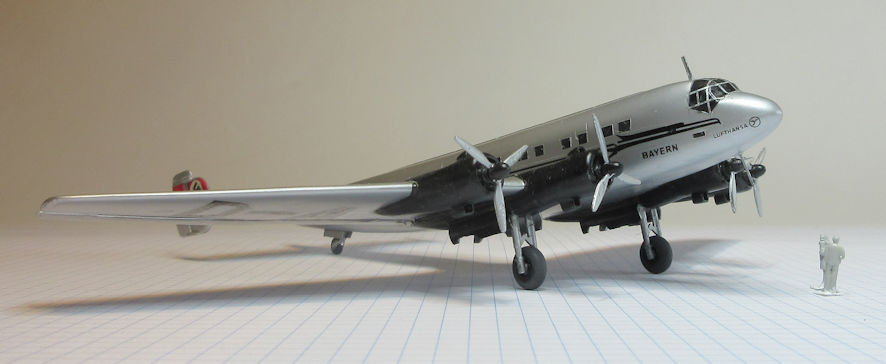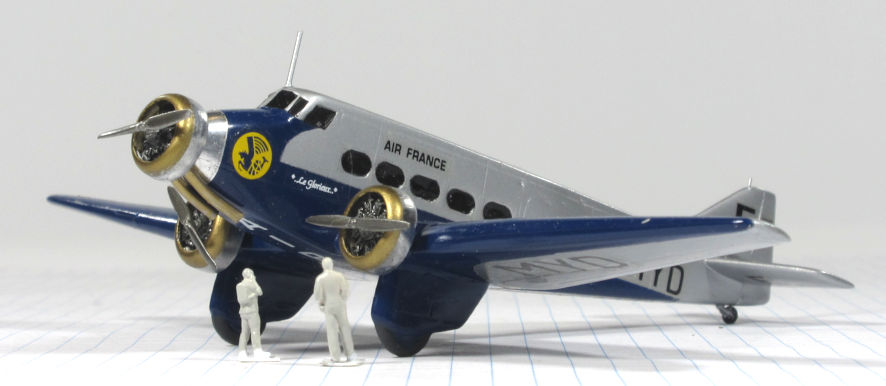1930s European Airliners
Wibault 283 – Junkers Ju90 – Armstrong Whitworth Atlanta

A wander around the gallery of 1930s aircraft is always interesting and instructive because there is so much variety and colour. It was a period when aircraft manufacturers were trying new things to improve their aircraft and the field had yet to consolidate so that there were many companies competing and innovating in search of the most efficient aircraft.
I always like looking at airliners and there are plenty to look at in this gallery. I wondered how I could narrow the selection down to only three, so I decided to concentrate on airliners made by European manufacturers. There are currently 16 of them in the collection (with more to come) so I needed to narrow the selection even further and hit upon the idea of models made from non-plastic kits. When I counted them I found that all the models are either made from vacformed or resin kits. Four of the models were made from vacform kits, two British, one German and one French, which made the final selection easy.
Armstrong Whitworth Atlanta in 1/144 by Air Craft Models
Britain’s major airline in the inter-war period, Imperial Airways, ordered the Atlanta airliners primarily for its routes in Africa. Eight were constructed and served the airlines routes there and then in India so, unlike most airliners of this period, it had air conditioning. It could carry up to eleven passengers but a flexible internal arrangements allowed it to also carry different amounts of mail and freight. By the beginning of World War II the Atlantas were all flying in India and were taken over by the Indian Air Force, which finally retired then in June 1944.
This is not a kit you will find easily these days. Air Craft Models was a company that released a range of 1/144 vacform kits in the 1990s but has now disappeared into the mists of time. For vacform kits in 1/144 the later releases are very impressive with finely moulded detail, white metal parts such as engines and propellers, and a good decal sheet. The instruction sheets are also very well produced and help the modeller through the construction process very easily.
You will find no mention of this kit in Scalemates but if you happen to have copies of magazines like Scale Models International published in the 1990s you will come across a few reviews of Air Craft Models kits. A review of their Douglas DB-66 Destroyer in the March 1992 issue includes the comment: ‘this kit offers more in the way of detail than many injection kits to this scale. The quality of the parts and the practical approach throughout mean there is nothing to daunt even the beginner and no reason why a splendid model should not result’. I’d agree with that.
Junkers Ju-90 in 1/144 by Air Craft Models
This aircraft was created for Deutsche Luft Hansa shortly before World War II. It used the wings and tail of the abandoned Ju89 heavy bomber project combined with a wider fuselage capable of accommodating forty passengers on long range flights. Eighteen were built and they entered service in 1938. With the advent of war they were pressed into military service and only two survived the war. The Ju90 was also used as the basis for the larger Junkers Ju290 that was used in many military roles.
This Air Craft Models kit was of the same high quality of the Atlanta with fine detailing, white metal parts and a good decal sheet. The thing that made it more difficult was the typical Junkers arrangement of having the control surfaces separate from the rest of the airframe, which created some serious difficulties which I overcame, I recall, with Bambi staples.
I’ve made another two Air Craft Models models, one of them is the equally excellent Blohm und Voss Ha139 mail plane which is also in the 1930s gallery. The review of this kit in the August 1994 issue of Scale Models International concludes; ‘All in all this is a fine little kit which should present few problems to even a novice vacform builder. Price £7.50.’ The real problem would not be in making a model from this kit but finding one in the first place. And if you do find one the price could be a challenge. I’ve seen them sell on ebay for anything from $18 to $180, depending on how keen the bidding was. However, if you really want to add some small scale inter-war airliners to your collection you will be a keen bidder.
Wibult 283 in 1/144 by VLE Models
The Wibault 283 was a twelve seat airliner which first flew as the Wibault 280 in November 1930. Following on from that was one Wibault 281 with an improved engine and another, the 282, with a new engine. Seven Wibault 282s were made, some flying for Air Union on its Paris-London ‘Golden Ray’ service. When Air France was formed in 1933 it took over the Air Union 282s and ordered ten 283s with increased fuel capacity and modified tails. Some of them were later taken over for military roles.
VLE Models was a little company run by Bob Wheeler until he died in 2011. Among its small range it offered five interwar airliners. They are more difficult to make than the Air Craft Models kits and I’ve had to consign one of them, the Sikorsky S.38, to the rubbish bin as being beyond my modelling skills. However, the Wibult 283 is perhaps the best and easiest VLE kit to make. Scalemates has a photo of the kit which you can see here – don’t get alarmed! If you want something easier to make F-Rsin offered a resin kit of the 283 with Air France decals. It is now out of production but you may still be able to find a copy on the interweb.
Checking the information to write this short report I discovered that this model is almost certainly a Wibault 282 rather than a 283 which, apparently because sources are scarce on the interweb, had a taller tail. VLE offered only the shorter tail while the F-Rsin kit has the taller tail, which need only be shortened to make it a 282. Air France flew both but if you have the skills and want to make the Air Union aircraft in its gorgeous red and gold ‘Golden Ray’ livery it will have to be a Wibault 282. Good luck with that.


